Traffic congestion occurs when traffic demand exceeds road capacity, or when an incident such as a traffic crash, a vehicle breakdown occurs or temporary roadworks take place, all of which temporarily reduce capacity and restrict traffic flow. In 2015-2019, congestion on Dutch national roads increased by a factor of 1.3 with the strongest increase in 2019. In 2020 and 2021, far fewer traffic jams were registered, which is probably due to the COVID-19 social distancing measures. Congestion due to roadworks occurs in only 2-3% of the cases.
Congestion crashes mainly occur at the tail end of a traffic jam. There, the speed of the traffic flow decreases sharply, which coincides with frequent and hard braking, and with a high risk of rear-end crashes. In the traffic jam itself, relatively little happens: traffic has almost come to a standstill. If a crash occurs, speed is low and the consequences are minor.
Research seems to show that congestion warning systems have a (slightly) positive effect on driving speed and the number of crashes. Extending these signalling and warning systems could prevent congestion-related crashes. At the moment, about 60% of the motorway carriageways in the Netherlands have signalling. Developments in vehicle technology, such as forward collision warning (FCW) and assisted braking, could also contribute to preventing (rear-end) congestion crashes. Theoretically, future vehicle developments could, however, also negatively affect road safety, because they could lead to distraction or diminish alertness. Such a negative effect could be greater in congestion situations.
It is unknown how many crashes currently occur during roadworks, because they are no longer registered. There are guidelines and standards for signposting roadworks with maximum clarity and safety. Unfortunately, these are not always complied with.
Traffic congestion and roadworks
Traffic congestion is defined in different ways. Rijkswaterstaat uses the term ‘congestion’ as a collective term for three kinds of stagnant traffic:
- Slow-moving traffic: traffic that does not, anywhere over a distance of at least two kilometres, drive faster than 50 km/h, but often faster than 25 km/h;
- Stationary traffic: traffic that, almost everywhere over a distance of at least 2 kilometres, drives more slowly than 25/km/h;
- Slow-moving to stationary traffic: slow-moving traffic over a longer distance, with stationary traffic at some sections [1].
Congestion notably occurs when traffic demand exceeds road capacity, when an incident such as a crash or a vehicle breakdown occurs or when roadworks take place, all temporarily reducing capacity and disrupting the traffic flow. The circumstances causing congestion may be permanent (for example at a lane drop on a motorway section or two motorways merging) or incidental (such as following a crash or broken down vehicle).
The RWS congestion registration system shows that in 2016-2019 ‘high traffic volume’ was the main cause of congestion on the Dutch main road network (70%-73%, see Table 1). This implies that road capacity could not meet traffic demand. In that period, crashes and incidents together caused between 22% and 26% of all congestion. The share of situations involving insufficient road capacity, crashes and incidents is reasonably stable, with small year-to-year shifts.
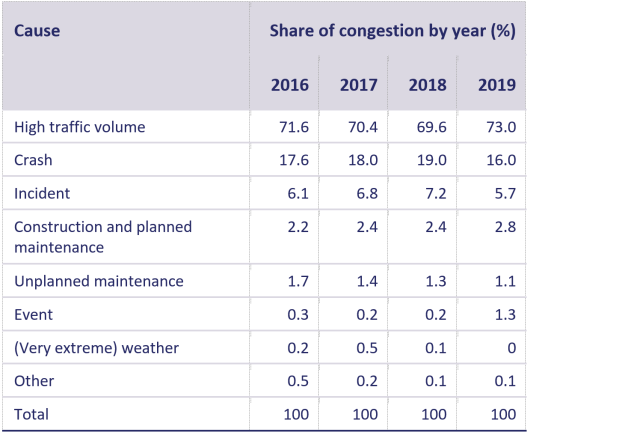
Table 1. Congestion causes by year [2] .
In a recent KiM survey, 15% of the respondents indicated driving in a traffic jam at least once a week for an average duration of 43 minutes. Over half of the respondents usually drove in a traffic jam during the afternoon peak hour and almost a quarter of them in the morning peak hour [3].
Objective data about the number of traffic jams are only available for national roads with signalling (Motorway Traffic Management - MTM). Traffic jams on the secondary road network are not (centrally) reported or registered. In 2015-2019, the number of traffic jams on national roads showed an upward trend, with a strong increase in 2019, see Figure 1. The lower figures in 2020 are due to the COVID-19 travel restrictions.
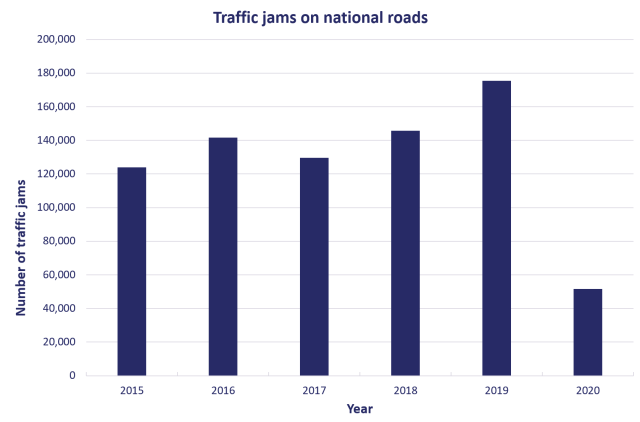
Figure 1. Number of traffic jams on national roads, by year (source: WVL, RWS [4] ). The low numbers for 2020 are due to the COVID-19 pandemic.
Short traffic jams are more frequent than prolonged ones. To assess the delay due to traffic jams, the congestion level is a better indicator than the number of traffic jams. The congestion level is the product of the average queue length and the average queue delay and is expressed in millions of kilometre minutes per annum. In 2019, the congestion level was 13.3 million kilometre minutes, while due to COVID-19 it decreased by 68% to 4.2 million kilometre minutes in 2020. Figure 2 shows the indexed congestion level of the national road network and the total vehicle kilometres travelled in 2000-2019. In 2008-2014, the congestion level decreased while the number of vehicle kilometres continued to grow. The 2008-2014 decrease may be due to steps taken to increase road capacity as part of the Beter Benutten (improved utilisation) programme (with measures such as peak hour lanes, storage lanes and adding narrow lanes by re-designing the existing cross-section). The effect of the programme was clearly temporary, since congestion levels after 2014 increased considerably.
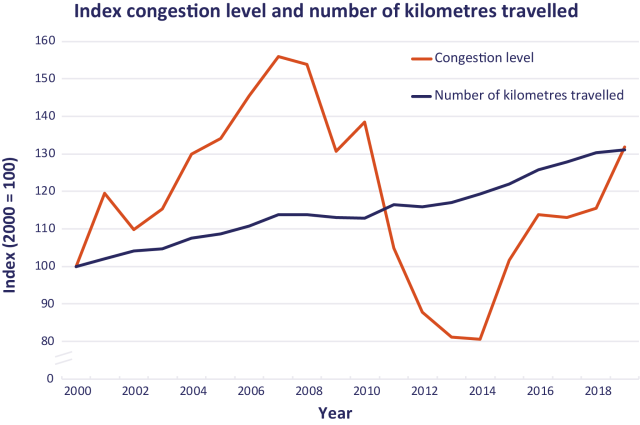
Figure 2. Development of indices of congestion level and number of kilometres travelled, compared to 2000 (source [2]).
The initial phase of congestion affects road safety differently than the traffic jam itself; particularly the risk of serious crashes is higher during imminent congestion than in the traffic jam itself. When congestion starts to occur, driving speeds (gradually) decrease, vehicles decrease their following distance, and the smallest disruptions (for example, a driver taking his foot off the accelerator or gently braking) result in traffic (kinematic) shock waves. The speed of the traffic flow steadily decreases from the point where the disruption occurred, which coincides with frequent and hard braking. This increases the risk of rear-end crashes. In the traffic jam itself relatively little happens: traffic is almost stationary. If a crash occurs, speed is low and crash consequences are minor. However, there is a significant risk of crashing into slow moving or even stationary vehicles at the back of the queue.
From crash registration in BRON (the National police registration), the annual number of crashes in traffic jams or during the initial phase of congestion cannot be determined. In 2004-2009, however, these data were registered by the police and they show that about 8% to 12% of all crashes (so including those with property damage only) on national roads occurred during congestion. In previous and following periods, these data were not recorded or the registration rate dropped to 0%. Several older studies allow us to conclude that traffic jams lead to a decrease in injury severity, but to an increase in the number of crashes [5]. In line with this, recent SWOV research [6] shows that the risk of an incident-related crash [i] in free-flow conditions is five times lower than in congested conditions.
[i] as reported by the Rijkswaterstaat incident reporting system
There is a strong link between crashes and traffic volume. The higher traffic volume, the higher crash risk and, usually, the more crashes [5] [7]. Research, however, shows that the increase in the number of crashes is not proportional to the increase in the number of vehicles (traffic volume). Because the number of crashes increases less rapidly, crash risk for individual road users is lower at higher traffic intensities than at lower intensities [8].
Results of research into the precise link between traffic volume and road safety are mixed. Some studies indicate that the number of crashes increases when traffic volume [i] increases, but that crashes are less serious [9]. Research by Lord et al. [10] finds a decrease in crash risk at increased traffic densities, while research by Wang et al. [11] does not find a link between crashes, crash severity, and traffic volume.
[i] Often expressed as I/C: the ratio between actual traffic volume (I) and theoretical capacity (C). The higher this ratio is, the higher the risk of congestion.
Literature reviews and in-depth studies show that, in congestion crashes on Dutch national roads, rear-end crashes are most frequent and side crashes are less frequent [5] [12] [13] [14] [15]. The causes are mainly related to insufficient distance keeping, inattentiveness, distraction and misjudgement of speed differences. Trucks are disproportionately involved in congestion crashes, and notably in rear-end crashes [16].
Research into fatal crashes on Dutch national roads in 2019 [14] shows that almost half of the fatal rear-end crashes occurred in the tail end of a traffic jam. This share seems relatively constant over the years in which the research was carried out [12] [13] [15]. At four out of ten locations where a fatal rear-end crash occurred in 2019, signalling (MTM) was operational. Four of the other six locations were known as congestion-sensitive locations. Also in 2015-2018, about half of all fatal rear-end crashes on Dutch national roads occurred in the tail end of a traffic jam, and at only one third of these locations signalling was operational.
An overview of registered incidents involving red-cross offences on motorways shows that, in 2020, ignoring a red-cross led to 54 crashes (with service cars, vehicle-mounted arrow boards/crash attenuators or due to other road measures) and 258 near crashes (see Table 2). It is remarkable that the number of near crashes seems to be highest in 2020, whereas at that time COVID-19 travel restrictions led to considerably less traffic. Nothing is known about the causes of this large number, but several disruptive factors may be at play, such as better registration and/or frequency of red crosses (it is highly likely that the reduced traffic demand in this period resulted in more peak-hour lanes being crossed off than would normally be the case)..
A red cross over a motorway lane implies that use of that lane is forbidden, for example due to a vehicle on the emergency lane or roadworks along the motorway. A red cross must not be ignored. In 2020, almost 5000 police reports on red cross negation were drawn up. Red cross negation endangers the lives of road workers, emergency service staff and other road users.

Table 2. Incidents after red cross negation on motorways in the Netherlands (Source [4]).
A pile-up is a road crash involving more than two and sometimes up to a hundred vehicles. The number of pile-ups in the Netherlands is unknown, since they are not registered separately.
Congestion warning systems have a (slightly) positive effect on driving speeds and crashes. This conclusion is based on explorative research; further research is needed.
Congestion warning systems are mainly roadside systems and include Automatic Incident Detection (AID, better known as the matrix panels over motorway lanes) and Dynamic Route Information Panels (DRIPs), which are Variable Message Signs (VMS) informing drivers and alerting them to a traffic jam, incident or dangerous situation in downstream traffic. Such systems make use of current traffic data (obtained from induction loops cut into the road surface). When congestion is imminent, the matrix panels on the road portals display lower advisory speeds, with or without flashing warning lights. In case of incidents (crashes, spilled cargo, vehicle breakdown etc), a RWS incident protocol takes effect which alerts the relevant (emergency) services. On roads with traffic signalling (MTM) a red cross will appear above and next to the incident lane. If necessary, the road inspector will demarcate the incident and traffic will be controlled (via DRIPs and/or on-site).
Literature reviews of the effect of dynamic speed limits (via matrix panels)conclude that they have a positive effect on driving speeds and crashes [17]. This conclusion is indicative and requires further research. Research into the effect of DRIPs – that only inform drivers about the situation on the road – shows varying effects on road safety [18]. Some studies show a strong positive effect when DRIPs have been activated, compared to when they have not. Yet, little difference was found in crash patterns and crash numbers between locations with or without DRIPs. De Ceunynck & Focant [18] conclude that the use of DRIPs may have a positive effect on crashes, particularly because they positively affect driving speed.
Since 1991, motorcyclists have been allowed to slowly drive between slow moving/stationary queues of traffic during periods of congestion (more commonly known as filtering). To encourage safe behaviour when this occurs, Motorplatform has drawn up a code of conduct during congestion for motorcyclists and drivers [19]. The code requests motorcyclists to choose an appropriate speed ( not more than 10 km/h faster than other traffic), to be alert to careless behaviour, to consider other motorcyclists, to use hazard lights when approaching or entering a traffic jam, and to use the regular traffic lane once the road is no longer congested. Drivers are also asked to be aware of motorcyclists filtering through traffic, and to take them into account.
In the Netherlands, it is unknown whether motorcyclists filtering through congested traffic leads to more crashes. A 5-year study in France shows that there was a 12% increase in the number of congestion crashes with motorcyclists on pilot routes where filtering through traffic during congestion was allowed, compared to a general decrease of 10% on the remaining road network [20]. In this study, of all the congestion crashes involving motorcycles, 90% were due to sudden lane changes by drivers and only 10% due to unchanged speeds (of the motorcycle).
Roughly, two types of measures may prevent congestion crashes: measures to prevent congestion itself or measures to prevent congestion-related crashes.
Preventing congestion
Structural congestion and congestion-related crashes can be reduced by decreasing traffic demand and/or (temporary) increasing road capacity. A reduction of traffic demand requires policy-based or legislative interventions leading to changes in travel mode, travel behaviour and vehicle use. Examples are increases of fuel taxation, road pricing [21] or banning the use of certain vehicles on certain roads or at certain times of day. To increase capacity, providing additional lanes is the most obvious measure. When space is too limited and the negative impact of an ever increasing traffic demand is too significant, utilisation measures can be taken, such as deploying peak-hour lanes or storage lanes (bufferstroken) during certain periods of the day.
Preventing congestion-related crashes
Congestion-related crashes can be prevented by both roadside and in-vehicle systems.
Roadside systems
In the Netherlands, MTM systems are applied; particularly Automated Incident Detection (AID) systems that are part of Dynamic Traffic Management (DTM). AID systems are aimed at reducing travel speeds when congestion is imminent or when an incident has occurred (see the question How much have congestion alert systems contributed to crash prevention?). Signalling (essential for these systems) is present on 48% of all national roads (this converts to 60% of the total length of driving lanes) [22]. Expansion of this system may have a positive effect on preventing congestion-related crashes [17].
In-vehicle systems
In-vehicle systems includes systems to prevent crashes, also during congestion, such as forward collision warning (FCW), adaptive cruise control (ACC), lane departure warning assistant (LDWA) and assisted braking (see SWOV fact sheet Intelligent Transport and Advanced Driver Assistance Systems (ITS and ADAS)). By no means all vehicles in the Netherlands are equipped with these technologies, and moreover, when the technology is present, it is often not enabled or is even deliberately disabled [23] [24]. As yet, the effect of these systems on congestion crashes is not conclusive. Some systems are of little or no help in crash prevention, the effect of other systems is unknown and a few have a considerable (positive) effect on road safety (also when there is no congestion). It is unknown whether ITS and ADAS also have unwanted side effects, although some systems could lead to distraction or reduced alertness. This negative effect could be greater in situations with traffic congestion.
Roadworks are a common phenomenon on the Dutch road network. Roadwork activities are diverse; they concern both preventive maintenance (before damage is incurred and scheduled as routine maintenance), and necessary/reactive maintenance (after damage or incidents, and unscheduled). The frequency of roadworks is hard to determine because they are not registered centrally.
Road authorities can record their roadwork projects in the t Melvin-system of the national traffic data portal (NDW). This is the successor to the Andes LTC system, and it can be consulted online.
It is unknown how many crashes currently occur during roadworks. Since 2010, the registration of roadwork crashes has not been reliable. In 1987-2004, the share of roadwork crashes on national roads was fairly stable (3.0-5.3% of all crashes on national roads). Along with reduced registration of mainly non-fatal crashes, this share decreased to 2.6-4.2% in 2005-2009 (bron: BRON).
Previous SWOV research [25] showed that, in 1987-2006, an annual average of 193 serious crashes occurred at roadwork locations (Figure 3). The number of roadwork crashes obviously depends on how often roadworks are in progress and over what road length; These data are not systematically recorded.
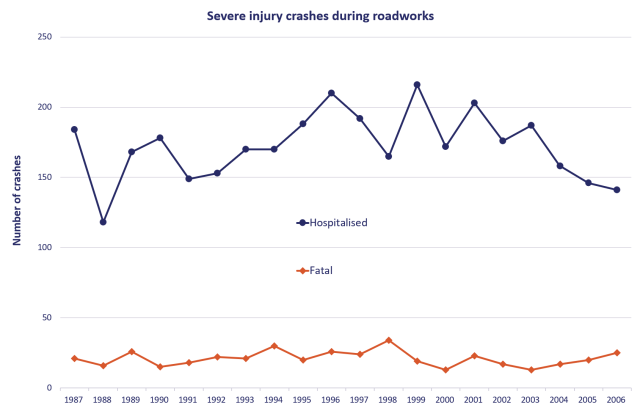
Figure 3. Number of registered severe injury crashes at roadwork locations in 1987-2006 [25].
The current crash registration system does not record the exact time and location of roadwork crashes. This information can only be found in older research which studied police reports [25]. For the period 1987-2006, this showed that the number of severe injury crashes at roadwork locations was highest on unnumbered roads (mainly municipal roads and 60km/h roads). Compared to all serious crashes, the share was highest on national roads [25]. Roadwork crashes mainly occurred during the day, but, of the total number of daylight crashes, the share of roadwork crashes during daylight equalled the share of non-daylight crashes at roadwork locations. In 83% of the crashes, vulnerable road users were involved, mainly pedestrian crashes and sideswipes of cyclists/moped riders, 17% of them being road workers.
Not much is known about the causes of roadwork crashes. Older research based on police reports found that, in the urban area, driving errors in yielding, reversing, and crossing were common contributory factors for this crash type. For crashes outside the urban area, speeding was a common crash cause (40%) [25].
A number of urban crashes are shown to be caused by mostly vulnerable road users (mainly cyclists) and other slow traffic turning into a road that is closed due to roadworks and then crashing with construction traffic, falling, or ending up in a ditch [25]. An assessment of fifty roadwork locations shows that cyclists are often given insufficient consideration. The road section is not always properly closed off, it is not always clear what adaptations in cyclist behaviour are expected, and the traffic sign ‘Cyclists dismount’ is sometimes incorrectly applied [26].
There are guidelines and standards to indicate roadworks with maximum clarity and safety (see below). Unfortunately, they are not always complied with. Compliance may improve by also making road safety audits (RSA) and road safety inspections (RSI) mandatory for roadworks. To realise speed reductions at a roadwork location, temporary average speed control or cameras could be an option, particularly for roads outside the urban areas. Within the urban area, lower speeds could be enforced by temporary speed humps or chicanes.
PIARC, the World Road Association, lists four safety principles that all roadwork projects should comply with (the so-called four Cs: Conspicious, Clear, Consistent and Credible) [27]:
- CONSPICUOUS implies that road users should see and recognise the work-in-progress situation and ‘automatically’ adapt their behaviour.
- CLEAR implies that all traffic signs, markings and measures should clearly indicate what is expected of the road user.
- CONSISTENT implies that roadworks should be carried out in a consistent and standardised way. There should not be any or hardly any deviations at locations with similar roadworks.
- CREDIBLE implies that communication with and the message to the road user should be credible to trigger adequate behaviour
Several CROW guidelines describe the principles and requirements for roadworks on motorways and rural roads [28] [29] and the measures needed [30] [31] to reduce crash risk for both road workers and road users (for an example, see Figure 4). A basic principle is a reduction of the maximum speed. For short-term roadworks (such as mowing of the verge or applying new markings), vehicle-mounted arrow boards and crash attenuators are used, or cones and yellow traffic signs. On motorways, lanes are crossed off and speed limits are reduced. Long-term roadworks require more substantial measures, such as temporary markings, securing the construction zone with traffic signs and with concrete and/or other temporary barriers. On motorways, measures vary from local road narrowing, a by-pass or lane closure (with a by-pass by means of the parallel carriageway). On rural single carriageway roads, a one-way system is applied and traffic is managed by on-site traffic controllers or traffic lights.
Recent research shows that there is room for improvement in quality control during planning and implementation of roadwork projects [32]. Previous Dutch research confirms that many roadwork projects fail where compliance with guidelines and standards is concerned [33].

Figure 4. Example of a correct road block for work in progress on motorways, short-term on locations with signalling: On the emergency lane, beyond 1.10 m from the edge marking [30].
Below you will find the list of references that are used in this fact sheet; all sources can be consulted or retrieved. Via Publications you can find more literature on the subject of road safety.
[1]. Wikipedia (2022). File (verkeer). Accessed on 23-03-2022 at wikipedia.org/wiki/File_(verkeer).
[2]. RWS (2020). Rapportage Rijkswegennet. 3e periode 2019, 1 september -31 december. Rijkswaterstaat.
[3]. Jorritsma, P., Hamersma, M. & Berveling, J. (2020). Blik op de file: De file door de ogen van de Nederlandse burger. KiM-19-A15. Ministerie van Infrastructuur en Waterstaat, Kennisinstituut voor Mobilitietsbeleid, Den Haag.
[4]. WVL (2021). Aantal files op rijkswegen naar jaar. Personal communication 2021. Rijkswaterstaat. Water, Verkeer en Leefomgeving WVL, Den Haag.
[5]. Marchesini, P. & Weijermars, W.A.M. (2010). The relationship between road safety and congestion on motorways. A literature review of potential effects. R-2010-12. SWOV, Leidschendam.
[6]. Schermers, G., Goldenbeld, C., Bijleveld, F.D., Nabavi Niaki, M., et al. (2019). Verhoging snelheidslimiet naar 130 km/uur en verkeersveiligheid. Effecten op snelheidsgedrag, incidenten, ongevallen en weginrichting. R-2019-30A. SWOV, Den Haag.
[7]. Chang, G.L. & Xiang, H. (2003). The relationship between congestion levels and accidents. Final report Grant SP 208B46. Department of Civil Engineering, University of Maryland, Baltimore, USA.
[8]. Hesjevoll, I.S. & Elvik, R. (2016). Effect of traffic volume on road safety. European Road Safety Decision Support System, developed by the H2020 project SafetyCube. Accessed on 22-12-2021 at www.roadsafety-dss.eu.
[9]. Zhou, M. & Sisopiku, V.P. (1997). Relationship between volume to capacity ratios and accident rates. In: Journal of the Transportation Research Board, vol. Transportation Research Record no. 1581, nr. Paper no. 970114.
[10]. Lord, D., Manar, A. & Vizioli, A. (2005). Modeling crash-flow-density and crash-flow-V/C relationships for rural and urban freeway segments. In: Accident Analysis and Prevention, vol. 37, nr. 1, p. 185-199.
[11]. Wang, C. (2010). The relationship between traffic congestion and road accidents: An econometric approach using GIS. Dissertation Loughborough University, London.
[12]. Davidse, R.J., Duijvenvoorde, K. van & Louwerse, W.J.R. (2020). Dodelijke verkeersongevallen op rijkswegen in 2018. Analyse van ongevals- en letselfactoren en daaruit volgende aanknopingspunten voor maatregelen [Fatal road crashes on national roads in 2018. Analysis of crash and injury factors and resulting potential countermeasures]. R-2020-26 [Summary in English]. SWOV, Den Haag.
[13]. Davidse, R.J., Louwerse, W.J.R. & Duijvenvoorde, K. van (2018). Dodelijke verkeersongevallen op rijkswegen in 2016. Analyse van ongevals- en letselfactoren en daaruit volgende aanknopingspunten voor maatregelen. R-2018-9. SWOV, Den Haag.
[14]. Davidse, R.J., Duijvenvoorde, K. van & Louwerse, W.J.R. (2020). Dodelijke verkeersongevallen op rijkswegen in 2019. Analyse van ongevals- en letselfactoren en daaruit volgende aanknopingspunten voor maatregelen [Fatal road crashes on national roads in 2019. Analysis of crash and injury factors and resulting potential countermeasures]. R-2020-29 [Summary in English]. SWOV, Den Haag.
[15]. Davidse, R.J., Louwerse, W.J.R. & Duijvenvoorde, K. van (2019). Dodelijke verkeersongevallen op rijkswegen in 2017. Analyse van ongevals- en letselfactoren en daaruit volgende aanknopingspunten voor maatregelen. R-2019-8. SWOV, Den Haag.
[16]. Vlierden, K. van (2006). Vrachtwagenongevallen bij files. Deel 1 - Internationale literatuurstudie naar oorzakelijke en/of bijdragende factoren. Steunpunt Verkeersveiligheid, Diepenbeek, België.
[17]. Daniels, S. & Focant, N. (2017). Dynamic Speed Limits. European Road Safety Decision Support System, developed by the H2020 project SafetyCube. Accessed on 22-12-2021 at www.roadsafety-dss.eu.
[18]. Ceunynck, T. de & Focant, N. (2018). Variable Message Signs. European Road Safety Decision Support System, developed by the H2020 project SafetyCube. Accessed on 07-03-2022 at www.roadsafety-dss.eu.
[19]. Motorplatform (2021). Samenspel in de file. Landelijk Motorplatform. Accessed on 22-12-2021 at motorplatform.nl/over-ons/samenspel-in-de-file/.
[20]. Beltrami, M. & Hiron, B. (2021). Expérimentation de la circulation inter-files des deux-roues motorisés. Cerema, Bron, Frankrijk.
[21]. Schermers, G. & Reurings, M.C.B. (2009). Verkeersveiligheidseffecten van de invoering van Anders Betalen voor Mobiliteit [Road safety effects of the introduction of Different Payment for Mobility]. R-2009-2 [Summary in English]. SWOV, Leidechendam.
[22]. Minister van IenW (2020). Vaststelling van de begrotingsstaat van het Infrastructuurfonds voor het jaar 2021. 35 570 A. Infrastructuur en Waterstaat, Den Haag.
[23]. Harms, I.M. & Dekker, G. (2017). ADAS: from owner to user; Insights in the conditions for a breakthrough of Advanced Driver Assistance Systems. Connecting Mobility.
[24]. Korse, M.L., Schermers, G., Radewalt, N.M.D., Hoog, A. de, et al. (2003). Op koers !? Resultaten van de proef met het Lane Departure Warning Assistant (LDWA) system. Directoraat-Generaal Rijkswaterstaat, Adviesdienst Verkeer en Vervoer AVV, Rotterdam.
[25]. Janssen, S.T.M.C. & Weijermars, W.A.M. (2009). Verkeersonveiligheid bij werk in uitvoering deel II. Een ongevallenanalyse [Road safety at roadworks Part II. A crash analysis]. R-2008-14 [Summary in English]. SWOV, Leidschendam.
[26]. Weijermars, W.A.M. (2009). Verkeersonveiligheid bij werk in uitvoering, deel III en eindrapportage. Beoordeling van werk-in-uitvoeringlocaties en een samenvatting van het gehele onderzoek [Road safety at roadworks, part III. Assessment of roadworks locations]. R-2009-4 [Summary in English]. SWOV, Leidschendam.
[27]. PIARC (2012). Improvements in safe working on roads. Report number 2012R29EN. World Road Association PIARC, Paris.
[28]. CROW (2019). WIU 2020 – Werken op autosnelwegen. CROW, Ede. Accessed on 20-04-2022 at kennisbank.crow.nl/.
[29]. CROW (2020). WIU 2020 – Werken op niet-autosnelwegen. CROW, Ede. Accessed on 20-04-2022 at kennisbank.crow.nl.
[30]. CROW (2021). WIU 2020 – Standaardmaatregelen op autosnelwegen. CROW, Ede. Accessed on 20-04-2022 at kennisbank.crow.nl/.
[31]. CROW (2019). WIU 2020 – Standaardmaatregelen op niet-autosnelwegen. CROW, Ede. Accessed on 20-04-2022 at kennisbank.crow.nl.
[32]. Várhelyi, A., Strnad, B., Develtere, A., Temmerman, P., et al. (2019). Road safety management at work zones – Final report. Deliverable No D3.2. CEDR Call 2016: Safety Incursion Reduction to Increase Safet in road work zones (IRIS), Brussel, Belgium.
[33]. Weijermars, W. & Spittje, H. (2008). Analysis of traffic safety at road works. In: Proceedings of European Transport Conference 2008 6-8 October 2008, Noordwijkerhout, The Netherlands.
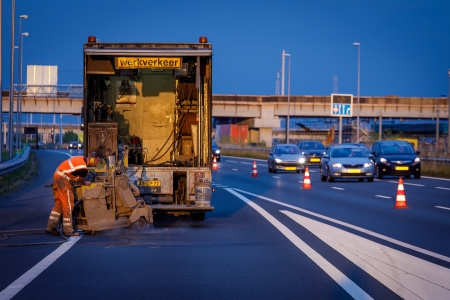
Would you like to cite this fact sheet?
Reproduction is allowed with due acknowledgement:
SWOV (2022). Traffic congestion and roadworks. SWOV fact sheet, May 2022. SWOV, The Hague.
SWOV publication
This is a publication by SWOV, or that SWOV has contributed to.
- Interested in more SWOV publications?
- Or would you like to continue your search in our other publications?
